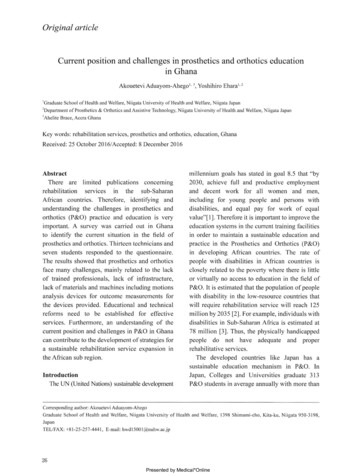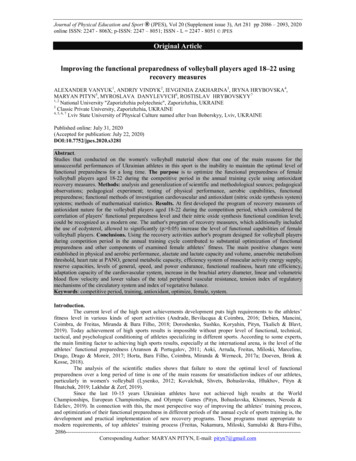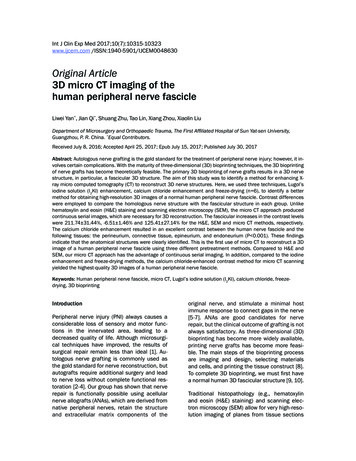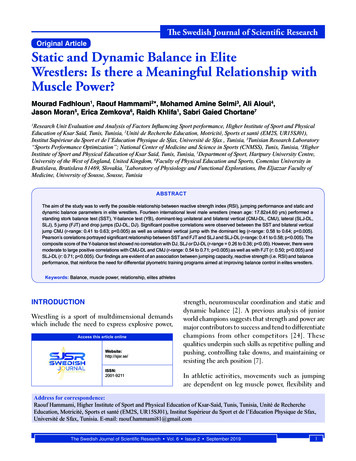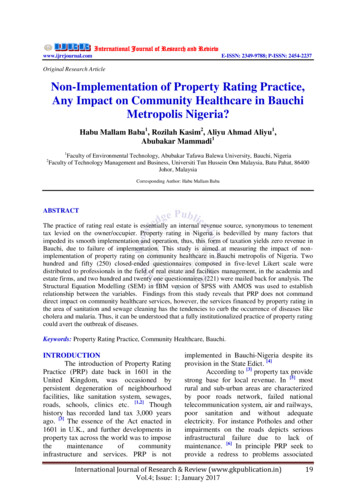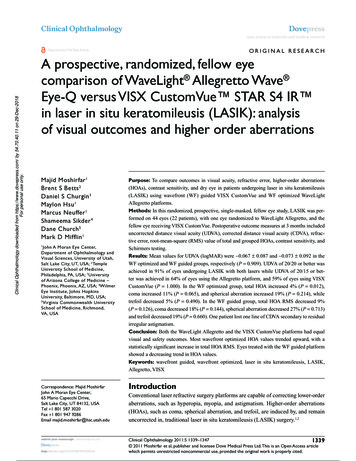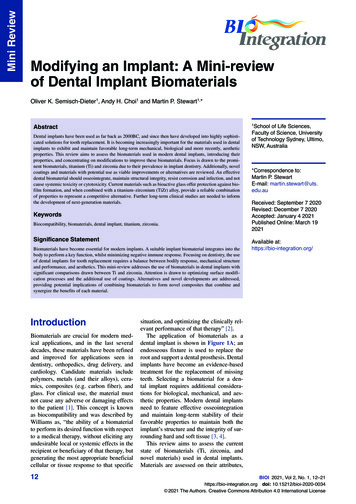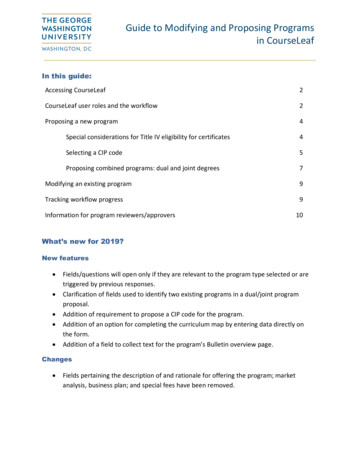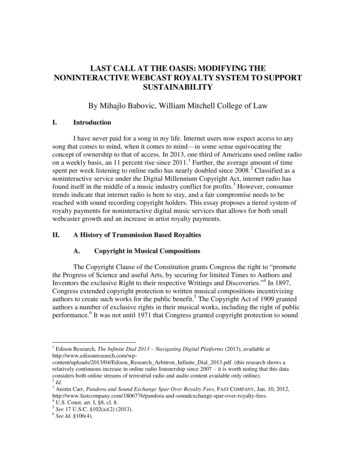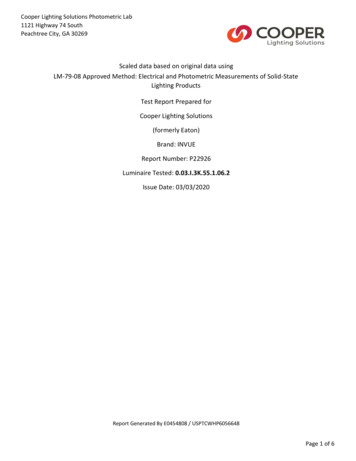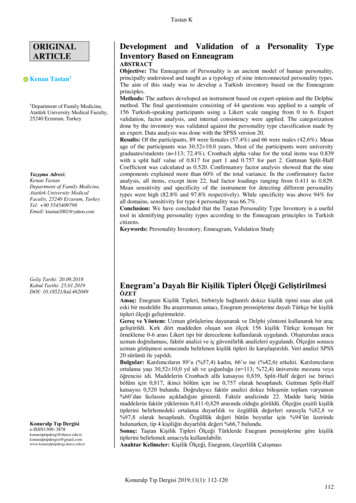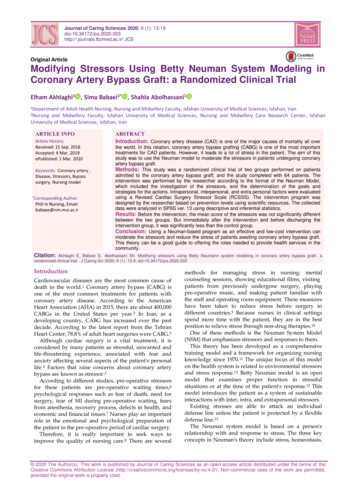
Transcription
Journal of Caring Sciences 2020; 9 (1): 13-19doi:10.34172/jcs.2020.003http:// journals.tbzmed.ac.ir/ JCSOriginal ArticleModifying Stressors Using Betty Neuman System Modeling inCoronary Artery Bypass Graft: a Randomized Clinical TrialElham Akhlaghi1 , Sima Babaei2* , Shahla Abolhassani11Departmentof Adult Health Nursing, Nursing and Midwifery Faculty, Isfahan University of Medical Sciences, Isfahan, Iranand Midwifery Faculty, Isfahan University of Medical Sciences, Nursing and Midwifery Care Research Center, IsfahanUniversity of Medical Sciences, Isfahan, Iran2NursingARTICLE INFOArticle History:Received: 15 Sep. 2018Accepted: 4 Mar. 2019ePublished: 1 Mar. 2020Keywords: Coronary artery ,Disease, Stressors, Bypasssurgery, Nursing model*CorrespondingAuthor:PhD in Nursing, Email:babaee@nm.mui.ac.irABSTRACTIntroduction: Coronary artery disease (CAD) is one of the major causes of mortality all overthe world. In this relation, coronary artery bypass grafting (CABG) is one of the most importanttreatments for CAD patients. However, it leads to a lot of stress in the patient. The aim of thisstudy was to use the Neuman model to moderate the stressors in patients undergoing coronaryartery bypass graft.Methods: This study was a randomized clinical trial of two groups performed on patientsadmitted to the coronary artery bypass graft; and the study completed with 64 patients. Theintervention was performed by the researcher according to the format of the Neuman Model,which included the investigation of the stressors, and the determination of the goals andstrategies for the actions. Intrapersonal, interpersonal, and extra personal factors were evaluatedusing a Revised Cardiac Surgery Stressor Scale (RCSSS). The intervention program wasdesigned by the researcher based on prevention levels using scientific resources. The collecteddata were analyzed in SPSS ver. 13 using descriptive and inferential statistics.Results: Before the intervention, the mean score of the stressors was not significantly differentbetween the two groups. But immediately after the intervention and before discharging theintervention group, it was significantly less than the control group.Conclusion: Using a Neuman-based program as an effective and low-cost intervention canmoderate the stressors and reduce the stress of patients awaiting coronary artery bypass graft.This theory can be a good guide to offering the roles needed to provide health services in thecommunity.Citation:Akhlaghi E, Babaei S, Abolhassani Sh. Modifying stressors using Betty Neumann system modeling in coronary artery bypass graft: arandomized clinical trial . J Caring Sci 2020; 9 (1): 13-9. r diseases are the most common cause ofdeath in the world.1 Coronary artery bypass (CABG) isone of the most common treatments for patients withcoronary artery disease. According to the AmericanHeart Association (AHA) in 2015, there are about 400,000CABGs in the United States per year.2 In Iran, as adeveloping country, CABG has increased over the pastdecade. According to the latest report from the TehranHeart Center, 78.8% of adult heart surgeries were CABG.3Although cardiac surgery is a vital treatment, it isconsidered by many patients as stressful, unwanted andlife-threatening experience, associated with fear andanxiety affecting several aspects of the patient's personallife.4 Factors that raise concerns about coronary arterybypass are known as stressor.5According to different studies, pre-operative stressorsfor these patients are pre-operative waiting times,6psychological responses such as fear of death, need forsurgery, fear of MI during pre-operative waiting, fearsfrom anesthesia, recovery process, defects in health, andeconomic and financial issues.7 Nurses play an importantrole in the emotional and psychological preparation ofthe patient in the pre-operative period of cardiac surgery.Therefore, it is really important to seek ways toimprove the quality of nursing care.8 There are severalmethods for managing stress in nursing: mentalcounseling sessions, showing educational films, visitingpatients from previously undergone surgery, playingpre-operative music, and making patient familiar withthe staff and operating room equipment. These measureshave been taken to reduce stress before surgery indifferent countries.9 Because nurses in clinical settingsspend more time with the patient, they are in the bestposition to relieve stress through non-drug therapies.10One of these methods is the Neuman System Model(NSM) that emphasizes stressors and responses to them.This theory has been developed as a comprehensivetraining model and a framework for organizing nursingknowledge since 1970.11 The unique focus of this modelon the health system is related to environmental stressorsand stress response.12 Betty Neuman model is an openmodel that examines proper function in stressfulsituations or at the time of the patient's response.12 Thismodel introduces the patient as a system of sustainableinteractions with inter, intra, and extrapersonal stressors.Existing stresses are able to attack an individualdefense line unless the patient is protected by a flexibledefense line.13The Neuman system model is based on a person'srelationship with and response to stress. The three keyconcepts in Neuman's theory include stress, homeostasis, 2020 The Author(s). This work is published by Journal of Caring Sciences as an open access article distributed under the terms of theCreative Commons Attribution License (http://creativecommons.org/licenses/by-nc/4.0/). Non-commercial uses of the work are permitted,provided the original work is properly cited.
Akhlaghi et al.,and patient perception. The role of the nurse is to focuson the factors influencing the individual's response tostress and protect the patient against the relevant riskfactors.14 The main objective of nursing in this model is toevaluate patients in terms of achieving stability throughthe acquisition and preservation of health. The nursecreates the relationship between the patient, theenvironment, and health and establishes a sustainablesystem. This system considers patient and nurse'sunderstanding of patient care. Due to the patient'sstability and his health outcome, it is necessary toevaluate the stressors perceived by the nurse and thepatient. With the progress of collaboration between thenurse and the patient and with their mutualunderstanding, they can eliminate their differentunderstandings and make a constructive relationship.The outcome of such a partnership is complementaryto a joint care plan that can be implemented on the basisof a clear objective.5 Neuman considers nurses as activecontributors.15 It should be kept in mind that theories inthe nursing profession are developed to be used inclinical practices. Developing and reviewing theoriesopens up new approaches to quality care and challengesthe current care practice.16 Nursing is both a practicaldiscipline and a science based on professionalknowledge; therefore, to create new practical approaches,establishing the foundation of knowledge is one of therequirements.17 Nurses must first be trained andprovided with nursing theories and models. Then, theycan improve the symptoms and complications ofcoronary artery bypass graft, and their care will beeffective. The researcher observes that the emotionalcomplications impaired the patient's emotional exertionand delayed their recovery. Additionally, according tothe researchers' experiences, a simple nursingintervention cannot solve the problems. Furthermore,based on previous studies, a general consideration isneeded to fill the gap in the intervention using theNeuman system model.Given the limited studies on Neuman theory based onclinical trial in Iran. Most of the past studies that haveworked on theories have been a case study, qualitative ordescriptive, that is not as well as randomized clinicaltrials. According to the importance of holistic care andthree levels of prevention in developing countries, whichare principles of the Newman model, the researcherattempted to answer the question about the probableeffect of a care program based on the Betty Neumansystem of stressors in patients undergoing coronaryartery bypass grafting. The aim of this study was toexamine the effect of Betty Neuman model on thestressors in patients undergoing coronary artery bypassgraft.Materials and methodsThe present study was a randomized clinical trial thatwas approved by the Vice-Chancellor of Ethics ofResearch and Technology of Isfahan University ofMedical Sciences (IR.MUI.REC.1396.3.838). It was also14 Journal of Caring Sciences, March 2020; 9 (1):13-19registered in the Iranian clinical trial center with the codeIRCT2018011603897N1. The required sample size with95% confidence and test power of 0.8 strength wasmeasured in two groups of 32 controls and intervention,including a total of 64 people. Convenience samplingwas done and allocation of subjects to the control andintervention groups was randomly assigned among thepatients who were waiting for coronary artery bypassgraft at the teaching hospital in 2018. The method ofrandomization is to write letters A and B on cards withequal numbers. Then, each of the patients who has beenadmitted to the study is asked to take one of the cards.Patients who take the A card allocated into theintervention group, and patients who take the B cardallocated into the control group.Inclusion criteria to the study included fullconsciousness, an age range of 30 to 70 years,hospitalization at least one day before the surgery, andmastery of the Persian language. Exclusion criteria werethe lack of cooperation of the patient at each stage of thestudy and the emergency condition of the patient. Datawere collected using a Revised Cardiac Surgery StressorsScale (RCSSS). Cardiac Surgery Stressors Scale (CSSS)was developed by Carr and Powers in 1986.18 White in1998, adding six items to CSSS introduced RCSSS19 whichhas been used in this study. The RCSSS included 37questions. The questionnaire consisted of two parts; thefirst part included personal and social information, andthe second part including RCSSS cases involved threesubgroups, intrapersonal stressors including 11 phrases,interpersonal stressors including 9 phrases, andextrapersonal stressors including 17 phrases. The itemswere ranked according to the level of concern of theparticipants on the Likert scale from 0 to 4 where 0 showslack of worries, 1 very low worries, 2 low worries, 3relative worry, and 4 worries. The lowest score of 0means that there is no stressor, and the maximum scoreof 148 refers to the highest stressor factor. Grading scoresfrom 0 to 37 indicates very low stressors, 38 to 74 showslow stressors, 75 to 110 indicates the existence ofrelatively stressful factors, with 111 to 148 displayingstressful factors. The reliability of this questionnaire ent 0.81), (nurse 0.93) method in Parvan et al.,studies5,20 in Iran. For the purpose of this study, thecontrol group and the intervention group were selectedby referring to the cardiology center and preparing a listof candidates for coronary artery bypass graft. Theresearcher then explained the goals of the study to theeligible patients individually. After obtaining thepatients’ informed and written consent for participationin the research, the personal data questionnaire wascompleted, using an interview. Then, the stressors ofcoronary artery bypass surgery were completed RCSSS.Patients who had had a level of education to answer thequestions were asked to complete the questionnaire.Otherwise, the completion of the questionnaire wascarried out in the form of a structured interview besidethe patient's bed. It took each patient 20 to 30 minutes to
Modifying stressors using neuman modeling in CABGcomplete the questionnaire. The questions were asked ina way that was understandable for the patients. For theintervention group, the pre-operative day care programwas designed by the researcher based on the BettyNeuman Model. First, the potential and actual stressorfactors and intrapersonal, interpersonal, and extrapersonal factors were examined using RCSSS. Then,proper goals and strategies were identified through usingthe questionnaire and determining the level of stressors.If the stressors were not available, interventions wereconducted at the first level of prevention. Furthermore,the influence of stressors on the natural defence line wasreduced by decreasing the probability of confrontationwith stressors and strengthening the defence line. At first,all stressors were considered as potential, and peoplewere at the initial prevention level. After determining theperceived stressors of the patient by using RCSSS(patient)20 at the time of admission, if the patient wasconceived of the stressors, immediately RCSSS (nurse)5was given to the nurse responsible for the patient andcompleted until the end of the shift. This was carried outto determine the stressors that the patient was facing. Thenurse perception was considered as one of the steps ofthe Neuman model in relation to the patient's stressors.The intervention was performed on the basis of the studyand considering the patient and nurse's understanding ofthe actual stressors for the patient at the second level ofprevention. These interventions were performed toreduce the identified stressors. At the second level of theprevention, the natural and the flexible defensive linesthat were injured interfered. The intervention was aimedat strengthening the internal defence lines in order toreduce the reaction. Preoperative reassessment of thepatient was done using RCSSS (nurse) and, if there werestressors, intervention continued in the third levelprevention. The third level prevention was providedthrough Benson relaxation technique. A care programwas performed based on the Neuman system model inone or two consecutive sessions of 45-60 minutes prior tothe first and second level prevention. The first sessionwas debated on the first day of admission in the morningshift (at 8-12), and the second session in the evening (at16-17) or night shifts (at 20-22).The conversations were carried out individually andon the patient's bedside face to face after a favorableatmosphere had been created between the patient and theresearcher. The contents of the sessions includedintroducing and expressing the purpose of the research,explaining in simple terms coronary artery anatomy,preoperative cardiac surgery, operating room and ICU,heart surgery, postoperative care (bathing, activities athome, diet, taking medication), the role of propernutrition in reducing stress and anxiety, reassurance inthe hospital and operating room environment, intubationin the mouth, chest tube, urinary catheter, etc. This wasdone in a first-time prevention based on the Neumannsystem model. At the end of the first session, there wasno meaningful booklet on the issues presented. The Chisquare test showed that there was no significantdifference between the two groups in the distribution ofpatients' gender and cardiac catheterization. With theplacement of people in the second level, the interventionwas designed to reduce stressors perceived by the nurseand the patient.Contents of sessions based on prevention levels were asfollow:First Session:- In patients in the first prevention and at the time ofadmission.- Introduce yourself and express the purpose of theresearch.- An explanation of coronary anatomy, preoperativecardiac surgery, operating room and ICU, post ICUcardiac surgery, post-operative care and instructions(bathing, activities at home, diet, taking medication),the role of proper Nutrition in relieving stress andanxiety,andreassuranceinthehospitalenvironment and the operating room.Second Session:- In patients in the secondary prevention and in thesecond shift after admission.- Discussion and clarification of issues.- Intervention according to the needs and actualstressors detected by the patient and the nurse andbased on Neuman Stressors.- Intrapersonal (awareness of the rehabilitation phase,home care, routine care in the intensive care unitand other areas, surgery awareness, time back toward, duration of exercise, awareness of thetherapeutic and nutrition therapy.- Interpersonal (description of hospital therapyprocedures, psychological support, and relation withpatients, and provide Information about medications)- Extra personal (providing information on insuranceand paying for expenses and talking to thehealthcare sector and referring patients to charities,creating a quiet environment and reducing noise,staying in the ICU, injection instruction, training inconnection with tubes and patient's chest tube, atutorial on catheter showing the patient withconnections).Third Session:-In patients with the third prevention and in thepost-operative stage.-Promote relaxation responses by implementingBenson's relaxation method.At the third prevention level, Benson's relaxation methodwas performed after the surgery. This technique is a formof relaxation that, with a comfortable position andclosure of the eyes, all the muscles in the body graduallyrelax from the feet to the face.21 This research is the resultof a master thesis in nursing and approved by the IsfahanUniversity of Medical Sciences with the code (396838).ResultsThis randomized clinical trial was completed withparticipation of 64 patients who were candidates forcoronary artery bypass graft in two equal groups ofpatients in the intervention group was 48 to 70 and 33 to69 years in the control group. Most of the participants inthe intervention group were in type 1 and type 2intervention and control )Figure 1). The age range of theJournal of Caring Sciences, March 2020; 9 (1): 13-19 15
Akhlaghi et al.,Figure 1. Flow chart of the studyprevention, and only 16% were in type III prevention. Ofthe total 32 patients in each group, there was nosignificant difference between variables in the controland intervention groups. Independent t-test showed thatthere was no significant difference between mean age, thenumber of previous hospitalizations, time of the mostrecent hospitalization, and the number of previoussurgeries. Chi-square test showed that there was nosignificant difference between the two groups in sexdistribution and cardiac catheterization.The Chi-square test with likelihood ratio alsoindicated that the distribution of marital status was notsignificantly different between the two groups.Additionally, Fisher's exact test showed that there wasNo significant difference in the distribution of religiousbeliefs between the two groups. The frequency of heartsurgery in family history was similar in the two groups.The Mann-Whitney test showed that there was nosignificant difference in family income, education leveland duration of previous hospitalizations between thetwo groups (P 0.05). The mean score of stressors beforethe intervention was not significantly different betweenthe two groups (P 0.59), but immediately after theintervention and before discharge in the interventiongroup, it was significantly less than that of the controlgroup (P 0.001) (Table 1).Table 1. Comparison of the mean score of stressorsbetween the two groupsVariableBefore theinterventionAfter trolMean(SD)Mean(SD)P 1) 0.001*(3.87)SD: Standard deviation,*statistically significant16 Journal of Caring Sciences, March 2020; 9 (1):13-19There was no significant difference in the score ofintrapersonal and extra personal stressors before theintervention (P 0.05), but immediately after theintervention and before discharge in the interventiongroup, it was significantly less than that of the controlgroup (P 0.05).There was no significant difference between the meanscore of interpersonal stressors b
1Department of Adult Health Nursing, Nursing and Midwifery Faculty, Isfahan University of . using a Revised Cardiac Surgery Stressor Scale (RCSSS). The intervention program was designed by the researcher based on prevention levels using scientific resources. . Modifying stressors using Betty Neuma

